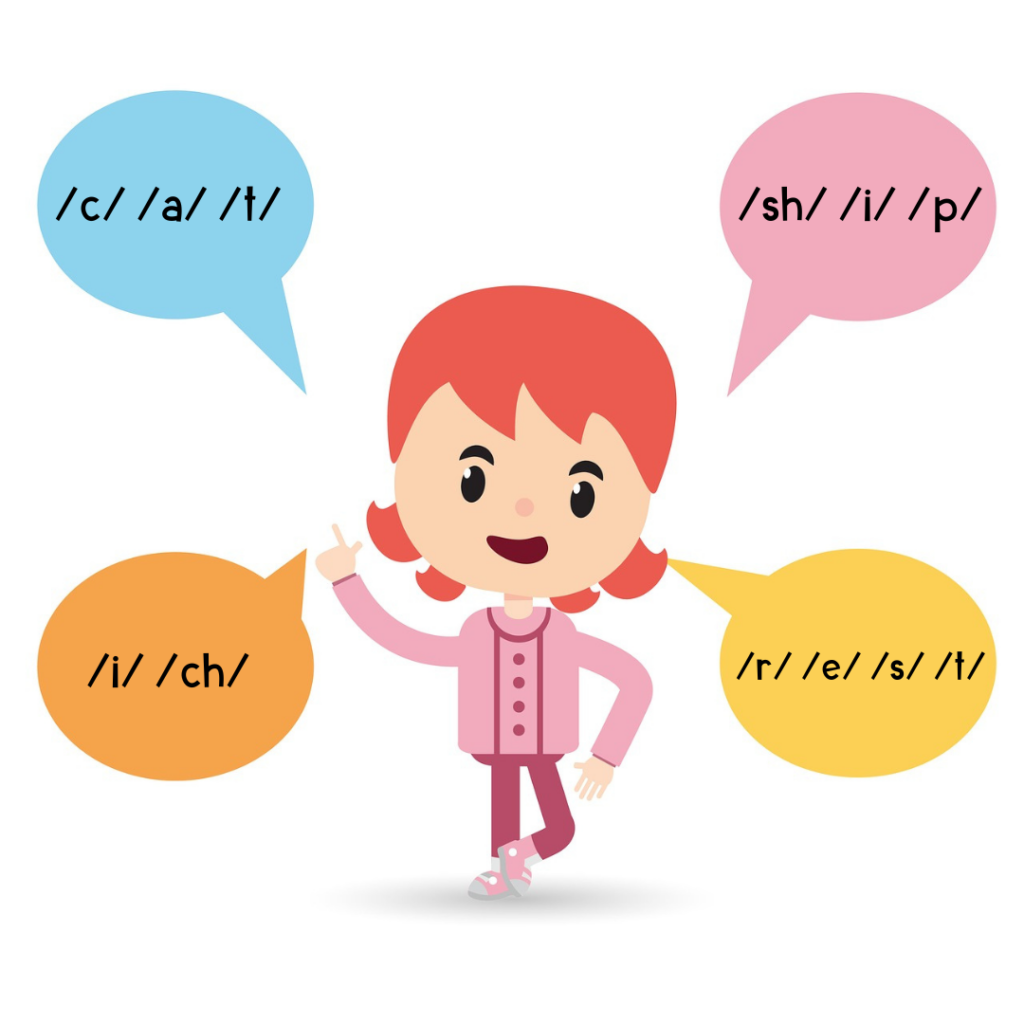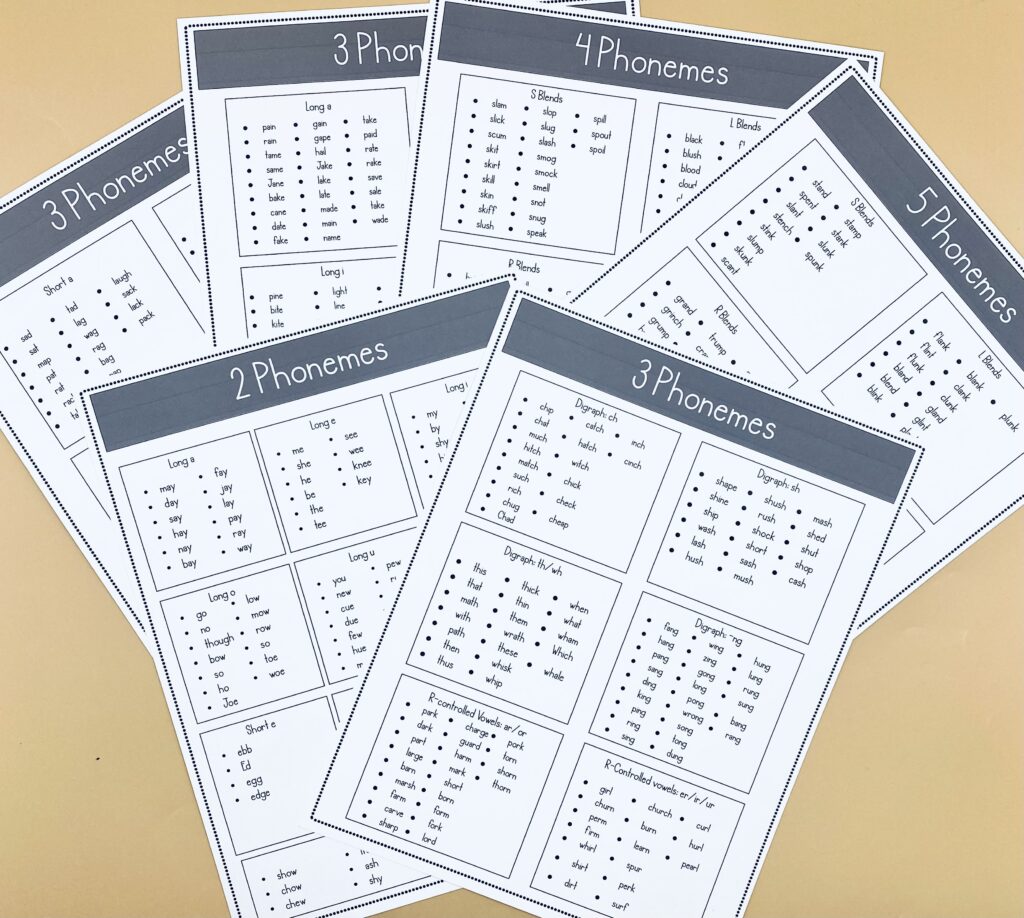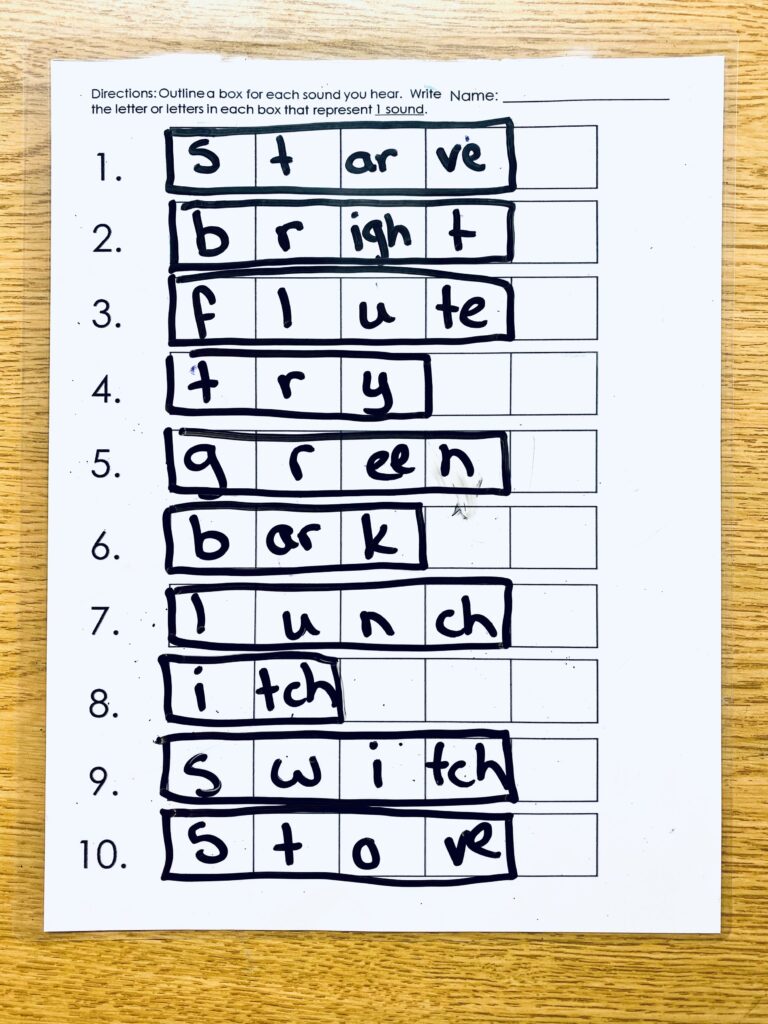
Share This:
I first started writing this blog post over two years ago. As I read the draft, it was amazing to me how much my understandings of phonemic awareness have changed and evolved since that time. When I first read Kilpatrick’s work, I remember thinking, “This is it. This is the answer. If my kids just have phonemic awareness, they will become readers.”
But, like so much else in this journey, it’s not that simple. Yes, phonemic awareness is ESSENTIAL for our learners, but phonemic awareness alone does not solve reading difficulties. So today, let’s talk about what it is, what’s important to teach, and how we can do it.
For adults, this may seem like no big deal. At Christmas dinner, I was “playing a game” with my daughter and niece where I would say sounds, and they had to put them together and tell me the word. My brother-in-law said, “I don’t get it, you’re just saying the word.” A skill that is quite obvious to us as adults can be labor-intensive and difficult for our students.
Put simply, phonemic awareness is the ability to manipulate INDIVIDUAL sounds in language. If you can tell me that the sounds in chart are /ch/ /ar/ /t/, then you are displaying your phonemic awareness. If I say /m/ /o/ /m/, and you tell me the word is mom, that is displaying your phonemic awareness.

Phonemic awareness is a subset of phonological awareness. Think of it like this—all squares are rectangles, but not all rectangles are squares. All phonemic awareness is phonological awareness, but not all phonological awareness is phonemic awareness.
Phonological awareness is manipulation of ANY sound. It includes skills like rhyming, counting words in sentences, syllable awareness, and phonemic awareness. Phonemic awareness may be more difficult for students because pulling apart individual sounds is harder than larger units of speech, like syllables and words. It is a big jump to go from the phonological awareness task of blending 3 syllables (com-pu-ter) to blending 3 phonemes (/c/ /a/ /t/).
Phonemic awareness is the most important predictor of future reading success in kindergarten and first grade. While phonological awareness skills may be helpful in the beginning, it is the phoneme level that matters the most. Children do not need to know how to rhyme in order to become successful readers.
There are some very popular phonemic awareness curriculums out there. I applaud the fact that they were focusing on phonemic awareness when many of us didn’t even know what it was.
But we simply do not have the evidence that 10-15 minutes of oral-only phonemic awareness activities will serve our students. (Check out this article that explains the current evidence we have on phonemic awareness.)

For most of our children, 1-2 minutes of oral-only phonemic awareness work will suffice. The rest of the time, phonemic awareness will be integrated with phonics to have the biggest instructional impact (more on that later).
So no, I do not think we need a program to teach phonemic awareness. But I also don’t think we need to throw out any programs we have. Instead, we can use the parts of it that make sense for our students, and leave out all the rest.
When you think of the range of phonemic awareness skills, they included the following: segmenting, blending, adding, deleting, substituting. Adding, deleting, and substituting are considered advanced phonemic awareness skills.
There’s a huge debate about advanced phonemic awareness skills. Is there evidence that supports students must have these skills to become proficient readers? As of right now, we do not have the research that says these skills are necessary to become proficient readers. In fact, we have some evidence that suggests that even proficient readers may struggle with these tasks.
What DO we know about the skills needed? We know that segmenting and blending phonemes are the two most important phonemic awareness skills. This is what we need to teach.
Think about it—when a child is trying to read an unfamiliar word, what do they have to do? They have to look at the letters, decide the sounds those letters represent, and then blend to read the word. Conversely, when looking to spell a word, children must segment the sounds in the word to write the correct graphemes.
So, unless you are teaching our earliest readers, this is my suggestion: focus on segmenting and blending (I use the lists below!). Now, let’s get into what this instruction looks like.

If you teach pre-school or kindergarten, you will spend some time focusing on not just phonemic awareness, but phonological awareness tasks. My kindergarten group is the only group where I do extended periods of oral-only phonemic awareness activities. I spent around 5 minutes daily working on phonological awareness tasks.
I do this because these students are at the beginning of their educational journey. Many children at this age cannot yet isolate phonemes. Some basic phonological awareness work, like blending syllables, can help move them towards those understandings.
I also do oral-only phonemic awareness work with these students because they do not yet know their letter sounds. I do not want to wait to teach phonemic awareness until they know letter sounds. Instead, we can work on both phonemic awareness and letter sound knowledge, then work to blend the two together as soon as possible.
Above all else, the most powerful thing we can do is to connect phonemic awareness instruction with letters. The National Reading Panel (2000) discovered that phonemic awareness instruction has almost double the effectiveness when letters are added. In studies where children manipulated letters as part of their phonemic awareness instruction, the effect size on reading outcomes was .59. Those that did not use letters had an effect size of .36.
The evidence is there-we need to add letters.
Yes, phonemic awareness is a skill that does not need letters to be practiced. Once you add letters, that becomes a phonics activity. But using a phonics activity can support the phonemic awareness skill.
One way to do this is to use sound boxes! Ask your students to tap the sounds before they spell a word. Then, they should use one box for each sound in a word.
Can it really be that simple? Yes, it can! You are drawing attention to the sounds in the word (the phonemic awareness component) and having them make the connection to the graphemes that represent those sounds. After all, phonemic awareness isn’t the end goal.

When I was in my pre-service program, I heard a lot about using manipulatives for math. We rarely discussed manipulatives for reading. And I think that is a huge missed opportunity. Using manipulatives to scaffold reading is a very effective tool.
When we use manipulatives for phonemic awareness, we are often using some kind of a counter to represent sounds. I like using unifix cubes* and double-sided counters. But you can use ANYTHING as a manipulative. Do you have counting bears? Use those to represent sounds! Does your 4 year old have a bunch of Megablox she no longer uses? Those can be used for sounds as well.
When we use a manipulative for sounds, it’s an additional support level. We don’t want to use them forever, but they can be a very effective tool.
So, in conclusion, what do we need to do? Unless you are teaching our youngest learners, we simply do not need to focus on phonological awareness. Since there is no evidence to support advanced phonemic awareness skills, let’s focus just on segmenting and blending. We also do not need extended periods of phonemic awareness instruction that is disconnected from print. Adding letters to our phonemic awareness instruction will yield much greater results than oral-only instruction.
I hope this blog post was informative, but I also hope it can take something off your plate. Phonemic awareness does not need to take much time, it doesn’t need to be fancy, and it can easily be incorporated into what you are already doing with your instruction. When it comes to our phonemic awareness, let’s think about tweaks we can make, instead of full-scale overhauls!
*As an Amazon affiliate, I may receive a small commission on items purchased through my link. This is at no cost to you, and helps me to continue to provide weekly free content!
Share This:

Savannah Campbell is a K-5 reading specialist. She has taught her entire 12-year teaching career at the school she went to as a child. She holds two master’s degrees in education from the College of William and Mary. Savannah is both Orton-Gillingham and LETRS trained. Her greatest hope in life is to allow all children to live the life they want by helping them to become literate individuals.

Savannah Campbell is a K-5 reading specialist. She has taught her entire 12-year teaching career at the school she went to as a child. She holds two master’s degrees in education from the College of William and Mary. Savannah is both Orton-Gillingham and LETRS trained. Her greatest hope in life is to allow all children to live the life they want by helping them to become literate individuals.
Feeling overwhelmed with all the terminology out there? Want to know the key terms all teachers need to teach phonics? In this FREE Rules of English cheat sheet, you get a 5 page pdf that takes you through the most important terms for understanding English—you’ll learn about digraphs, blends, syllable types, syllable divisions, and move. Grab today and take the stress out of your phonics prep!
